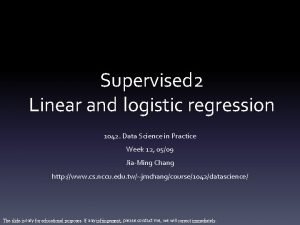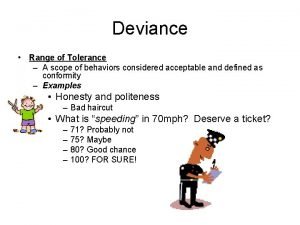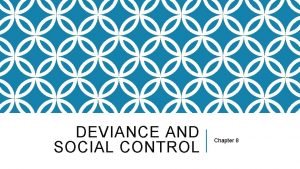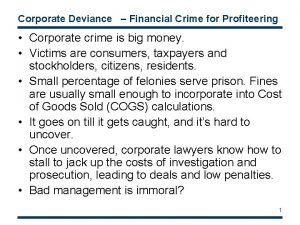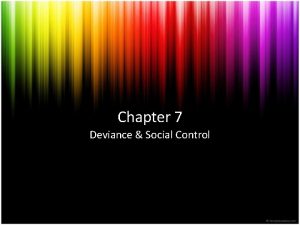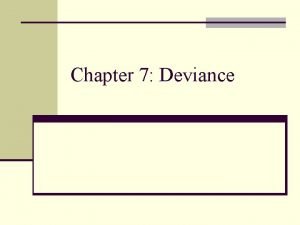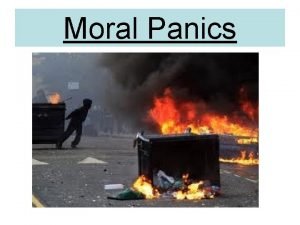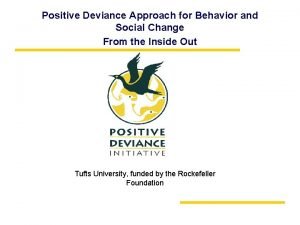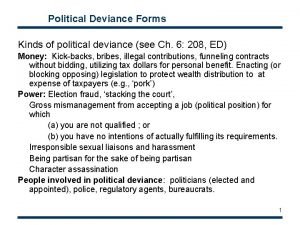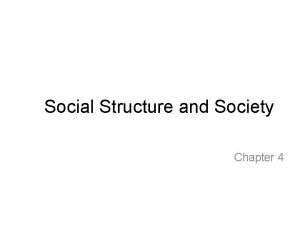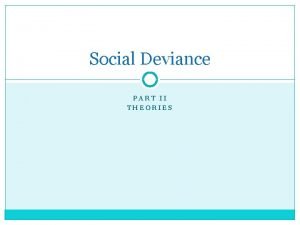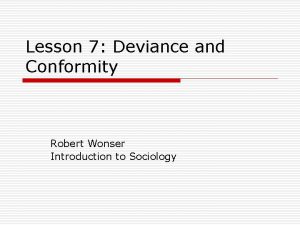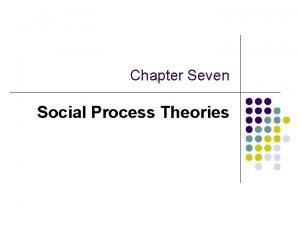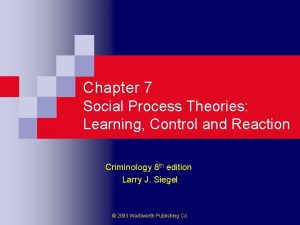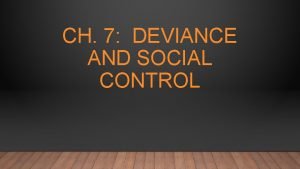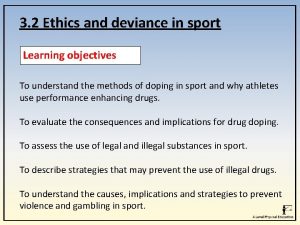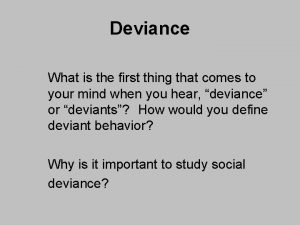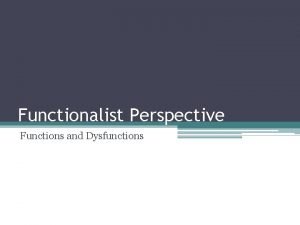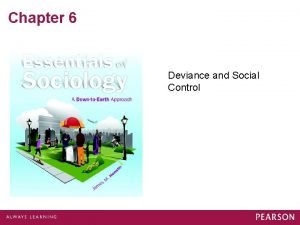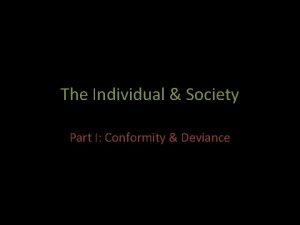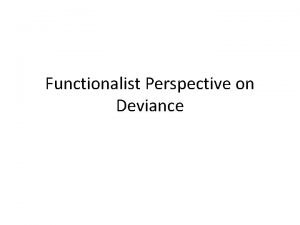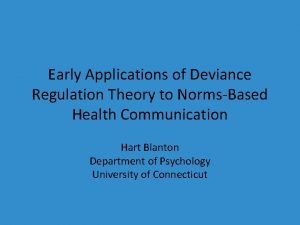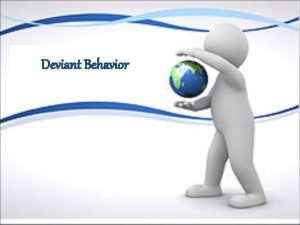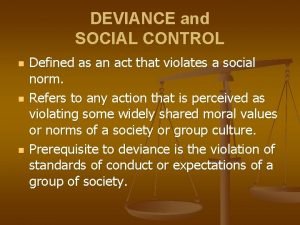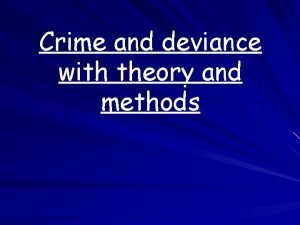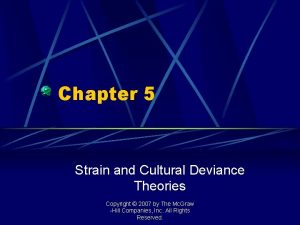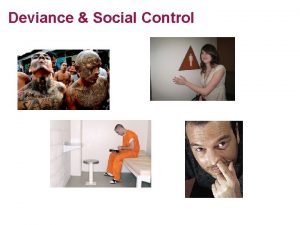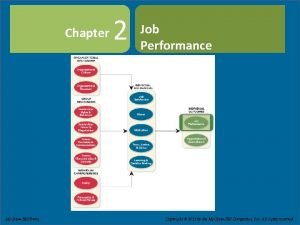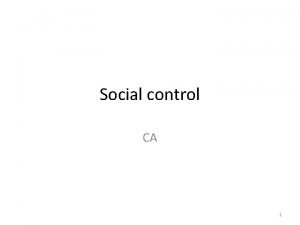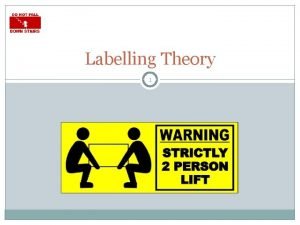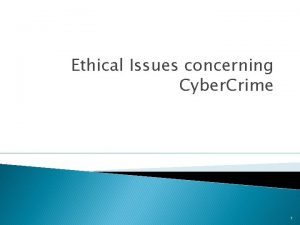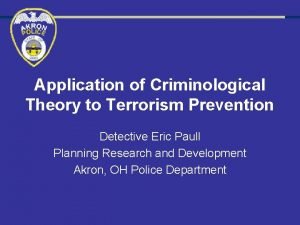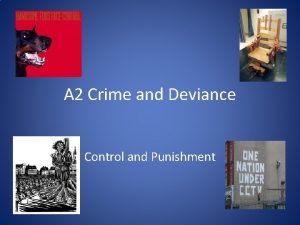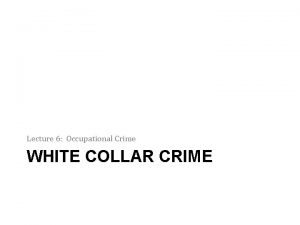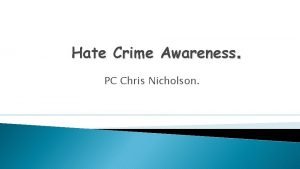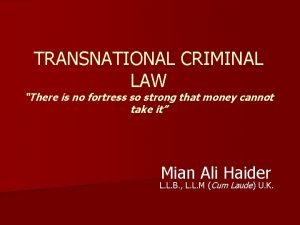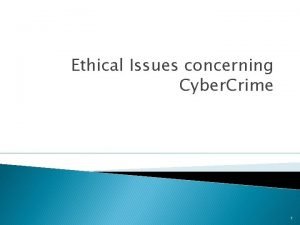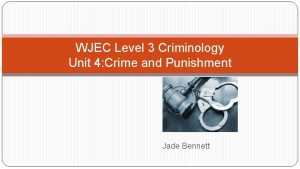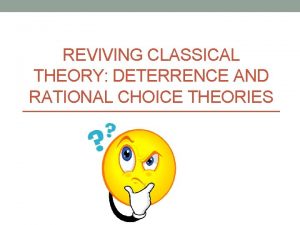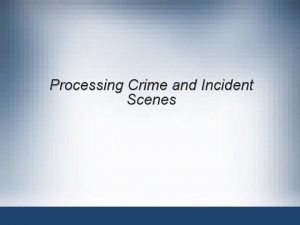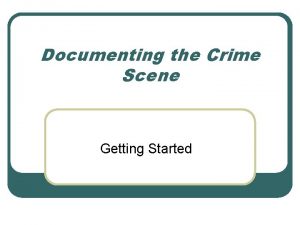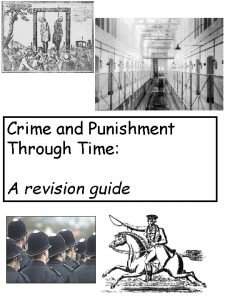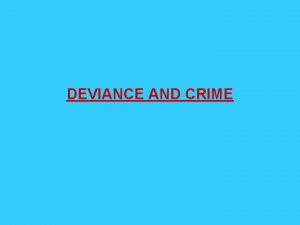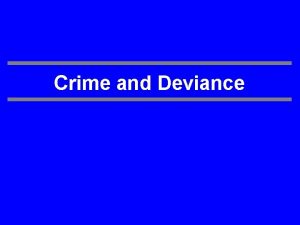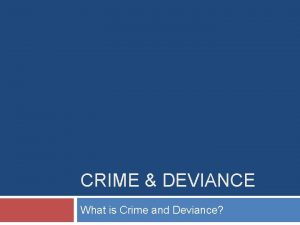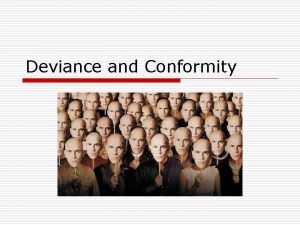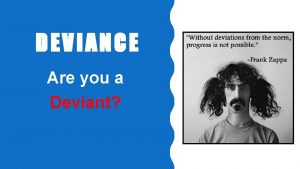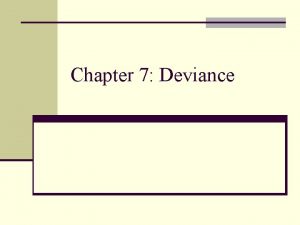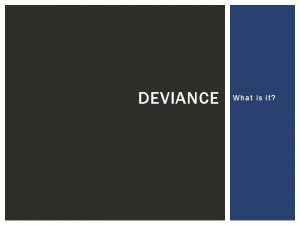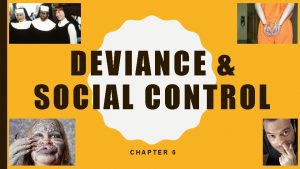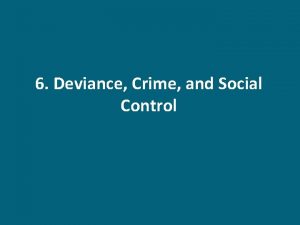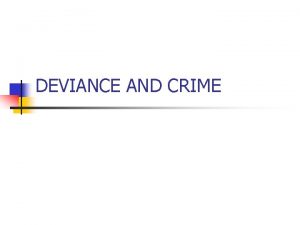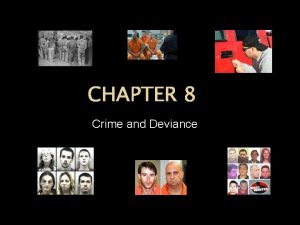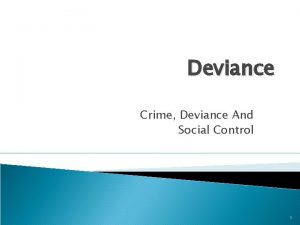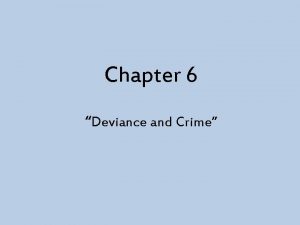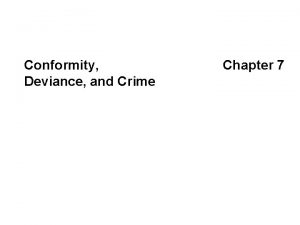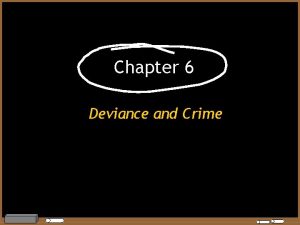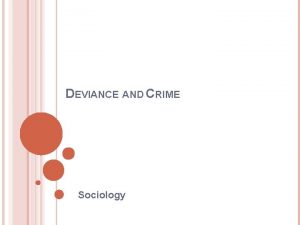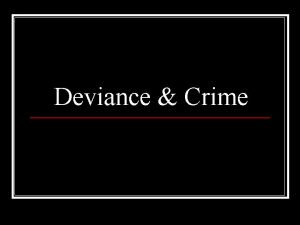Crime and Deviance Definition Crime and Deviance is





























































- Slides: 61

Crime and Deviance

Definition Crime and Deviance- is defined as variation from the norm and society’s reaction to it.

Labels • To label someone deviant is related to our notions of social convention…. the normal society…entrenched with laws, rules and norms.


Crime and Deviance A major area in sociological research: • - We are all interested in the deviant : Crime TV…. Law and Order, Cops etc. . Hero mystique-Robin Hood PEOPLE -OUTSIDE THE NORM


The Social Self The `deviant’ are reflections of ourselves and our sense of “otherness” • Self and society –connected but not the same. We are not automatons.

Comparative differences between Canada and the US • Illustration of differences in political culture, levels of racism etc. . • Canada is more conservative, elitist, less individualistic…than US… • Our law: Burkean • American Law: Lockean…

Frontier thesis, • US 50% of all homicide involved handguns whereas in Canada this figure was only 10% • Frontier thesis, Canadian have firmer control in monarchial system than in the American Republic. . • Our policing is more peaceful.

Canada vs. US • US=Overt Racism-American are blatantly racist whereas Canadians are polite racists. • Canada= Covert Racism (Kallen, 1974; Mc. Cauley, 1990) • This evident in the culture of American vs. Canadian cities, hiring practices, social segregation etc.

Policing-Cops vs To serve and protect • Canadians have firmer control in monarchial system than in the American Republic, policing is more peaceful • Canadian system is Burkean in nature as opposed to Lockean • Burke-social control • Locke –individual rights and freedoms

. Burke • . Burke maintained the crime control model which held that personal freedom can only be achieved through social control

John Locke, on the other hand, advocated the due-process modeldue process seeks to ensure useful safeguard in favour of the individual over the system

• Although both systems reflect classic liberalism, there are qualitative differences in the perception and treatment of deviance.

Qualitative Deviance Concepts • Measures of Deviance Include: 1. 2. 3. 4. SEVERITY PERCEPTION DEGREE OF AGREEMENT LABELLING

Qualitative Deviance Concepts • Measures of Deviance Include: • 1. Severity- capital punishment-the more serious the crime the more we take freedom away…

Perception • 2. While society speaks with a collective conscience on certain matters of crime such as murder. • On other matters there may be a continuum of responses from extremely harmful to inconsequential…

3. Degree of agreement • . Degree of agreement- across nations there are some behaviours that are agreed upon as seriously, deviant and against the codes of social order-collective conscience extends to all human life.

Examples. . 1. 2. 3. 4. • Armed robbery, Sexual assault, Incest, Murder- Anthropologists tell us that the incest taboo is almost universal as is aversion to cannibalism.

Severity and Degree of Agreement • Conflict crimes- are those crimes in which there exists conflicting opinions about their nature. (severity and degree of agreement do not match)

• 1. Ie. drug use and sexual activity- we know that these things are bad for us…but are they deviant? or simply immoral? Streaking? •

4. Labelling • Labeling theory (or social reaction theory) is concerned with how the selfidentity and behavior of an individual is influenced (or created) by how that individual is categorized and described by others in their society.

Negative Labels • The theory focuses on the linguistic tendency of majorities to negatively label minorities or those seen as deviant from norms, and is associated with the concept of a self-fulfilling prophecy and stereotyping

Labelling • Labeling theory (or social reaction theory) is concerned with how self-identity is influenced

Self Fulfilling Prophecy? • (or created) by how that individual is categorized and described by others in their society. • Labels can lead to self-fulfilling prophecies.

Sanity Insanity: A Social Construct • E. Goffman Asylums, for which he gathered information at the National Institute of Mental Health in Washington, D. C

Rosenthan (1973) • Rosenthan (1973) and his team had themselves committed…they complained of hearing voices and they were labeled schizophrenic…. • .

Sociological Approaches Theorization follows other empirical topics and draws upon paradigms 1. Conflict, 2. Symbolic Interactionist 3. Structural functional

Paradigms

Theories of Deviance I. Structural Functionalism • Structural Functionalism- structural strain, dysfunction-the school, family, religion and the polity are supposed to produce order, • DEVIANCE=dis-equilibrium and nonconformity.

Function and Dysfunction • There is some suggestion that deviance is not dysfunctional but functional…

Functionalist solution: Individualistic • a. Change Values- Commitment and control…the system teaches us control; some do not buy into it;

Delinquent Subculture • Subcultural Theories-delinquent subculture-socialization theories… • Also a functionalist approach-socialization paradigm • Culture of poverty –O. Lewis. .

Ie. Merton (1957)-structural strain • Anomie-absence of social regulation, normlessness- deviance results from problem of strain or disequalibrium…

Merton (1957) • …between culturally defined goals (money, power, success) and the socially accepted means of achieving them…(education)

Functional/Disfunctional Adjustment Four way individuals adjust to a conflicting society include: 1. innovation, 2. ritualism, 3. retreatism 4. and rebellion

II. Symbolic Interactionism • SI is less concerned with values, attitudes and behaviours (Anomie) than with the meanings that people attached to situation… • Definitions of context….

Edward Sutherland (1924) • Edward Sutherland (1924) one of the fathers of criminology developed the concept differential association to refer to not only association between individuals but also between ideas. • Sutherland = Learning Theory and symbolic interactionism.

Sutherland –crime in context • Deviance and criminal behaviour develops among those who define the behaviour favourably. • In any given situation or context, an individual if the weight of the favourable definition of crime exceeds the unfavourable definition, then criminal activity will result.

Street vs Suite Crime • White collar crime, for example, is rationalized along these lines… • Sutherland proves this through a study of 100 imprisoned embezzlers…. Each felt they were helping `the company’ and its operation.

Ethnicity, Class and Addiction 1. IRISH: `Paddy Wagon’ 2. ITALIAN `MOBSTER’ 3. . BLACK `DRUG DEALER’

SI CONCEPTS • SELF IDENTITY • LABEL • SELF FULFILLING PROPHECY

To Symbolic Interactionists • IDENTITY IS SOCIAL CONSTRUCTED • MEANINGS ARE DEVELOPED THROUGH RELATIONSHIP WITH OTHERS • INTERACTION-LOOKING GLASS SELF

Symbolic Interactionists • Symbolic Interactionists-G. H Mead, C. Cooley • We all can identify with criminals. • See Chicago School studies: 1. Street Corner Society 2. Social Order of the Slum 3. The Professional Thief

Self-fulfilling prophecy • A self-fulfilling prophecy is a prediction that directly or indirectly causes itself to become true.

Sutherland –crime in context • Deviance and criminal behaviour develops among those who define the behaviour favourably. • .

Criminal as `Professional/ crime as work’ • . Another interesting aspect of symbolic interactionist approach is the notion of crime as work.

Crime School highly skilled Prisons are like schools, , . 1. Mechanical skills-burglary, safe cracking explosive 2. Social skills- fraud embezzlement

III. Conflict Theory/ • Focus on dominant societal groups…. . • These groups impose labels upon members of subordinate societal groups.

Conflict theorist and Crime • Conflict theorists evaluate sub-culture on the level of class analysis. I. e. Labels • Subcultures form in reaction to class consciousness and ideology. • Crime is about scarcity!!!!

Spitzer (1975) • Criminals challenge the social relations of production…. • The oppressed threaten existing social relations and therefore must be controlled.

Class and Deviance • Schmidt, Smart and Moss (1968) found that lower class alcoholics were more likely to receive drug intervention therapy whereas upper class alcoholic were more likely to receive talk therapies.

Crime and Political Economy • Conflict Theory • Commitment to a psychiatric ward is often not much different from jail. • Jail is more likely in neo-liberal societies • Today’s emphasis on capitalism vs. state intervention.

Criminals challenge capitalism • Criminals challenge bourgeois ideology a. Notions of production, b. Social conditions of production c. Patterns of distribution and consumption d. Socialization processes e. Dominant ideologies.

Conflict Theory and Crime • a. When the poor steals from the rich he/she challenges are notion of appropriate human labour

• b. When the poor person collect welfare or refuses to work in the way we feel is best-the system is undermined?

Conflict Theory and Crime • c. When the drug user escapes or transcends culture rather than uses drugs for sociability, he/she de -legitimizes our notions of adequate social adjustment

• d. When juvenile delinquents fail to attend school they challenge our notions of adequate socialization into our on-going legitimate social order

• e. When organizations (underworld) develop they undermine the ideology that supports capitalistic society

Summary • Crime is a societal indicator of the relationship of individuals to the larger social system • Crime is relativistic • Crime is related to factors such as race, class and gender • Understanding crime helps understand other aspects of society and socialization

Learning to Labour: Paul Willis • : How working class kids get working class jobs. • Willis combines Marxist and symbolic interactionist forms of analysis • Looks at education and youth, deviance • British school system vs. `The Lads’
 Myra mawby
Myra mawby Null deviance vs residual deviance
Null deviance vs residual deviance Crime and deviance sociology revision
Crime and deviance sociology revision Chapter 7 deviance crime and social control
Chapter 7 deviance crime and social control Difference between crime and deviance
Difference between crime and deviance Marxism crime and deviance
Marxism crime and deviance Example of deviance
Example of deviance Chapter 8 deviance and social control
Chapter 8 deviance and social control Financial crime
Financial crime A person who breaks significant societal or group norms
A person who breaks significant societal or group norms Involver behavior
Involver behavior Deviancy amplification definition
Deviancy amplification definition Positive deviance sociology definition
Positive deviance sociology definition What is political deviance
What is political deviance Deviance in sport examples
Deviance in sport examples Primary and secondary deviance examples
Primary and secondary deviance examples Deviant overconformity in sports 2020
Deviant overconformity in sports 2020 Merton’s typology
Merton’s typology Inner and outer controls work against deviance
Inner and outer controls work against deviance Lesson quiz 7-1 deviance and social control
Lesson quiz 7-1 deviance and social control What is social process theories
What is social process theories Social process theories
Social process theories Lesson quiz 7-5 deviance and social control
Lesson quiz 7-5 deviance and social control Ethics and deviance in sport a level pe
Ethics and deviance in sport a level pe Example of informal social control
Example of informal social control Functions and dysfunctions of deviance
Functions and dysfunctions of deviance Chapter 6 deviance and social control
Chapter 6 deviance and social control Example of control theory
Example of control theory Normalization of deviance ppt
Normalization of deviance ppt Functionalist perspective on deviance
Functionalist perspective on deviance Deviance regulation theory
Deviance regulation theory Deviant overconformity
Deviant overconformity Criminal deviance
Criminal deviance Strain theory sociology
Strain theory sociology Cultural deviance theory
Cultural deviance theory Discouraging criminal acts by threatening punishment.
Discouraging criminal acts by threatening punishment. Biological explanation of deviance
Biological explanation of deviance Deviance is relative
Deviance is relative Employee behaviors that intentionally hinder organizations
Employee behaviors that intentionally hinder organizations Nature of social control
Nature of social control Labelling theory lemert
Labelling theory lemert Essay on cyber crime
Essay on cyber crime Crime definition
Crime definition Criminal psychology meaning
Criminal psychology meaning Situational crime prevention definition
Situational crime prevention definition Situational crime prevention definition
Situational crime prevention definition Occupational crime definition
Occupational crime definition Crime scene reconstruction definition
Crime scene reconstruction definition Professional ocupational crime
Professional ocupational crime Crime coverage form
Crime coverage form Mate crime definition
Mate crime definition Locard's principle of exchange definition
Locard's principle of exchange definition Transnational crime definition
Transnational crime definition Cyber crime meaning
Cyber crime meaning Wjec criminology unit 3 notes
Wjec criminology unit 3 notes Crime scene factoring and quadratic functions answer key
Crime scene factoring and quadratic functions answer key Rational choice theory key concepts
Rational choice theory key concepts Processing crime and incident scenes
Processing crime and incident scenes Crime scene factoring and quadratic functions answer key
Crime scene factoring and quadratic functions answer key Transnational crime and the developing world
Transnational crime and the developing world Sketch all serious crime and crash scenes
Sketch all serious crime and crash scenes Crime and punishment revision guide
Crime and punishment revision guide

